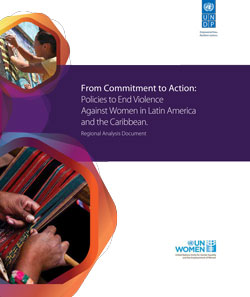
Policies to eradicate violence against women in Latin America and the Caribbean

What progress has the 33 countries of Latin America and the Caribbean made in relation to the enactment of legislation and the development of national policies and / or plans to address violence against women between 2013 and 2016? The findings of the study constitute a tool of high technical and political value for States to meet the goal of eradicating violence against women.
The report was prepared by the United Nations Development Program, UNDP, and the United Nations Entity for Gender Equality and the Empowerment of Women, UN Women, and it is based on the responses of 33 countries to a questionnaire to the National Mechanisms for the Advancement of Women and bilateral interviews with some of their representatives, carried out during 2014 and 2015, in addition to the review of secondary sources of information.
This study identifies the advances in the institutional approach of violence against women in the region and is a contribution on the learning of the implementation of national policies and plans of great utility for multiple countries that are in processes of formulation, implementation and evaluation of their own plans and public policies. It also presents promising experiences in the areas of prevention, attention, sanction and reparation of violence against women developed by some states and provides recommendations to them to address the critical issues that persist in the response to violence against women in the region.
CRITICAL KNOTS FOR THE ADVANCEMENT
Need to strengthen the leadership of the Institutional Mechanisms of WOMEN (MAM). for the advancement of women to energize, direct and manage plans and policies. Insufficient budgetary resources for the implementation of national policies and / or plans for violence against women. Weakness in the continuity of the implementation of public policies and national plans. Institutional response fragmented and with little coherence. Lack of robust information and measurement systems on violence against women that allows us to understand the dimension of the problem and design policies and responses based on evidence. Plans do not sufficiently reach the sub-national and local levels. Persistence of patriarchal cultural patterns that naturalize violence against women, affecting both society and the institutions themselves responsible for implementing plans and policies. Insufficient monitoring and evaluation of the impact and scope of national policies and / or plans.
RECOMMENDATIONS
Social pacts between government, private sector and society. to generate the commitment of all relevant actors to eradicate violence against women
National plans at the local level to ensure that local authorities and other actors work to address violence against women on site.
Policies with a multidimensional approach that address the different factors that contribute to eliminate violence against women.
Strategic interventions that address the priority aspects and have a multiplier effect.
Strengthen reparation actions for victims, especially those of economic empowerment to help them get out of situations of violence.
Work with men to transform violent masculinities, bring programs to schools and workplaces, and work with men, especially young people, as partners in the fight for the eradication of violence against women.
Participation of women's organizations and social actors in the design and monitoring of policies and programs.
Download the document here.